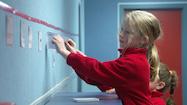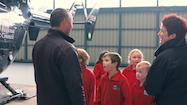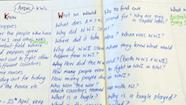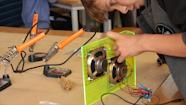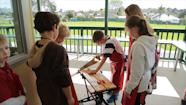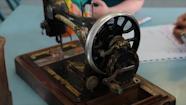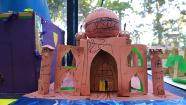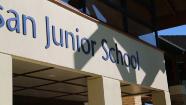Andrea Robertson describes the richness of their "amazing flight inquiry" – incorporating EOTC and learning in technology, literacy, and numeracy.
Technology and literacy in years 3–4: Flight inquiry
Transcript
Andrea Robertson: We’ve been doing an amazing flight inquiry this term, and we started with the point of wanting to definitely get out and about and use EOTC to really have experiences with flight.
We did some things in class to start off – just finding out what children’s ideas were about flight, what they knew, what they didn’t know, what they wanted to find out, and then headed into a whole almost two weeks of doing lots of going out into the community and seeing flight in action.
We wanted to, with flight, obviously look at the science side of flight as well, but really come at it with a technology focus and we knew that we wanted in each of the three classrooms to look at a different type of flight – so for example, paper planes, kites, and then another class did parachutes.
We also wanted, with it being the ten week term, we had a great chance to make something with a technological design process and then also hopefully be able to adapt it and make changes, so really not just rush it – to take the whole ten weeks and to do it well. In particular, this time round, we wanted to really integrate literacy and numeracy and even visual arts as well. We wanted the whole term to be jam packed and really focused on flight.
So, we have a really collaborative approach to our planning. We have, over five years, we have different inquiries, really general topics that we’re doing. For example, last year it was "Change", there’s "Challenge", and this year it’s "Learning to be …". So, in term 1, we broke that down into "Learning to be the best that I can be", which is our school motto. This term it’s "Learning to soar", next term we’re doing it with the Olympics and our school production’s on, so we’re going to do "Learning to perform at the best of our ability".
One thing that we do each term, is we use one of our CRT days, which I think really values our time as a teacher. Our whole syndicate gets together and we spend the whole day planning together. This allows us to just really look at coverage and integrate as much as possible. We also then talk to the other syndicates to make sure that we’re not crossing over, and that we’re getting good coverage school-wide as well. So for example, we knew that we hadn’t done, in technology, technological knowledge for a couple of years and we hadn’t done a lot of focus on modelling prototypes and materials so that’s been our focus with technology in this round, as well as the technological design process has been a focus as well.
So, with our integrated inquiry, we have managed to touch on numeracy, literacy, visual art. The children made these amazing clay birds. But in particular, the literacy’s been an area that I’ve been really amazed with how much we could connect with technology and connect with this whole topic of flight. It was a simple journal search that managed to identify lots of journals around flight, the Connected series, which has got really great technological articles, and there were some great flight articles in the Connected series. Right down to poetry, so we ended up doing quite a poetry focus, in particular around kites, and there was a lot of great language and things there.
Student 1: Where are you going my beautiful kite? Flying so high in the sky.
Student 2: I’m going to visit the lost balloons, I must fly away, fly away, fly.
Student 1: When I hold your string, my magical kite, why do I feel the wind in my hand?
Student 2: The wind is the taste of the sky my young friend, that I give to the child in the land.
Andrea Robertson: Also, in writing, we were able to do instruction writing – so children made kites, paper planes, and then wrote instructions about them. We had thank you letters to the three different places that we visited for EOTC – so real life, not just "today we’re going to write a letter to a pretend someone". This was real-life letter writing.
The instructions, we’ve done the instructions on how to make a kite and then gone on to how to make a milkshake and we’ve made milkshake, so we’re keeping it real. So we’ve also done recount writing, so following all of our EOTC trips, we did amazing writing about the experiences. And we write in books but we also use Google Docs and so children made slideshows following their trips to the airport and to the museum. We took lots of photos and so I was able to share the photos with all the children in my class and then they made their own presentations with a recount of what they’d done.
So, it was just really meaningful literacy that happened. I did a journal search and was amazed at the amount of resources that there were, but in my class, I’ve got a year three to four class, children working on level one and so there were lots of Ready to Read books that fitted into flight and other PMs and you know, once I started looking with that real focus, it was easy to find books that fit for all different reading age levels.
We were really impressed with our writing, it really stood out. I think just with the power of the experiences that the children had had with visiting the various EOTC places with flight.
Related videos
Technology, mathematics, and science in years 3–4: Flight inquiry (03.38)
Andrea Robertson and Lisa Hocking share how mathematics and science were incorporated into their technology learning.
Technology flight inquiry: EOTC in our community (04:27)
Dean Gordon shares how visits within the local community created understanding of the made and natural worlds.
Technology as a part of a cross-curriculum inquiry (04:52)
Anne Bunton explains how the technology learning area gave purpose to a class project.
Technology and science work well together (04:39)
Steve Jeffares and Ronnie McHale share how their students deepen conceptual understandings through integrating multiple knowledge bases.
Planning for technology at primary (03:59)
Jude Black and Diana Comp describe their approach to planning at Green Bay Primary.
Hooking primary students into technology (02:34)
Diana Comp shares some of her strategies for engaging primary students and growing understandings in technology.
Building technology inquiries in years 1–6 (02:47)
Shannon Maloney talks about building rich technology units within a programme of inquiry in years 1–6.
Planning for a coherent programme in primary (02:11)
Science and technology teacher Shannon Maloney shares how she works collaboratively with teachers to integrate technology into their programmes....

